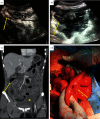Abdominal Tuberculosis Complicated by Intestinal Perforation
- PMID: 33628536
- PMCID: PMC7889363
- DOI: 10.1155/2021/8861444
Abdominal Tuberculosis Complicated by Intestinal Perforation
Abstract
Although relatively rare, there is an increasing incidence of abdominal tuberculosis (TB) in the developed countries, with the peritoneum being the most common site of involvement. Manifestation of abdominal TB should be considered in patients with relevant clinical symptoms and risk factors, including a history of prior TB infection and residence in or travel to an area where tuberculosis is endemic. We report a case of intestinal tuberculosis with a complicated disease course after the completion of treatment. Persisting abdominal symptoms during or after treatment should raise suspicion of subclinical intestinal obstruction. Early clinical recognition and surgical treatment may avoid poor outcome due to intestinal perforation.
Copyright © 2021 Michiel L. Sala et al.
Conflict of interest statement
The authors report no conflicts of interest.
Figures

Similar articles
-
Co-occurrence of Tuberculous Meningitis and Intestinal Perforation in Abdominal Tuberculosis (TB): A Report of a Rare Case From Pakistan.Cureus. 2024 Feb 28;16(2):e55132. doi: 10.7759/cureus.55132. eCollection 2024 Feb. Cureus. 2024. PMID: 38558686 Free PMC article.
-
Diagnosis and treatment strategies of tuberculous intestinal perforations: a case series.Eur J Gastroenterol Hepatol. 2012 May;24(5):594-9. doi: 10.1097/MEG.0b013e328350fd4a. Eur J Gastroenterol Hepatol. 2012. PMID: 22293329
-
Acute abdomen revealing abdominal tuberculosis complicated by a proximal jejunal perforation: Case report.Radiol Case Rep. 2024 May 20;19(8):3301-3307. doi: 10.1016/j.radcr.2024.04.082. eCollection 2024 Aug. Radiol Case Rep. 2024. PMID: 38817639 Free PMC article.
-
Tubercular bowel perforation: what to do?Ulus Travma Acil Cerrahi Derg. 2011 Jan;17(1):66-74. doi: 10.5505/tjtes.2011.39145. Ulus Travma Acil Cerrahi Derg. 2011. PMID: 21341138 Review.
-
Abdominal tuberculosis: Is there a role for surgery?World J Gastrointest Surg. 2017 Aug 27;9(8):174-181. doi: 10.4240/wjgs.v9.i8.174. World J Gastrointest Surg. 2017. PMID: 28932351 Free PMC article. Review.
Cited by
-
Value of MSCT plus MRI in the Detection of Colon Cancer.Evid Based Complement Alternat Med. 2022 May 31;2022:6507865. doi: 10.1155/2022/6507865. eCollection 2022. Evid Based Complement Alternat Med. 2022. Retraction in: Evid Based Complement Alternat Med. 2023 Dec 13;2023:9804916. doi: 10.1155/2023/9804916. PMID: 35685721 Free PMC article. Retracted.
-
Uncommon ileal perforation due to intestinal tuberculosis: A case report and literature review.Medicine (Baltimore). 2025 Jan 3;104(1):e41099. doi: 10.1097/MD.0000000000041099. Medicine (Baltimore). 2025. PMID: 40184116 Free PMC article. Review.
-
A Rare Case of Intestinal Tuberculosis with Chronic Partial Small Bowel Obstruction in a 37-Year-Old Ethiopian Man.Int Med Case Rep J. 2022 Dec 14;15:725-733. doi: 10.2147/IMCRJ.S388269. eCollection 2022. Int Med Case Rep J. 2022. PMID: 36540622 Free PMC article.
References
-
- Rathi P., Gambhire P. Abdominal tuberculosis. Journal of the Association of Physicians of India. 2016;64(2):38–47. - PubMed
Publication types
LinkOut - more resources
Full Text Sources
Other Literature Sources

